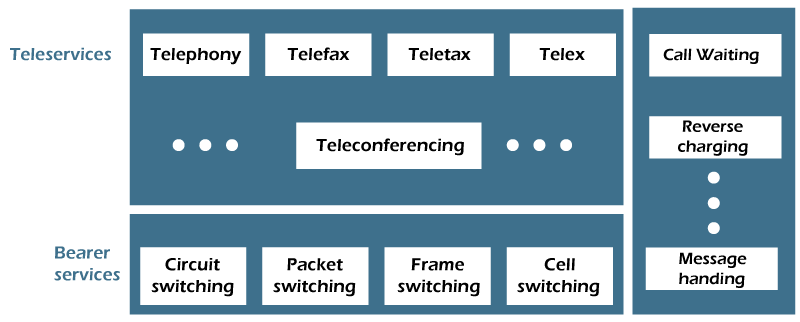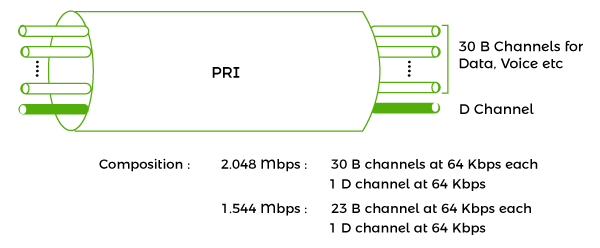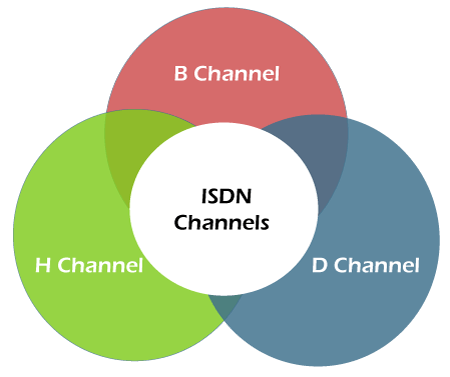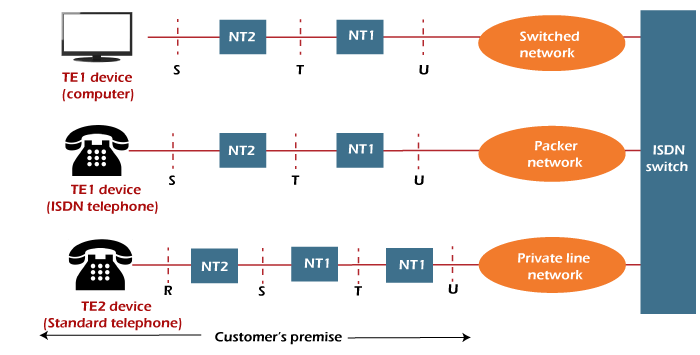Integrated Services Digital Network
In this article will learn about the ISDN. In this we will learn about the introduction, various principle, services and ISDN channels in detail.
Introduction:
ISDN is a set of protocols that is based on high-speed fully digitized telephone service. The main aim of ISDN is to provide a fully integrated digital service to the users.
In ISDN there are following three types of ISDN services:

Bearer Services:
This type of services is used to transfer information such as voice, data, and video between the users without manipulating the content of the network information. It belongs to the first 3 layers of the OSI reference model.
Tele Services:
In these types of services, the network may change the contents of the data. It belongs to the last 4 layers of the OSI reference model. It includes telephony, tele box, fax, and teleconferencing etc.
Supplementary Services:
It provides additional functionality to the bearer services and teleservices. Some of the examples of supplementary services are reverse charging, call waiting, and message handling.
Principles of ISDN:
Following are the principles of ISDN are:
- It supports both circuit switching & packet switching with the connections at 64 kbps.
- In ISDN layered protocol architecture is used for specification.
- ISDN services provides maintenance.
- ISDN services includes some network management functions.
- In ISDN network several configurations are possible for implementing.
ISDN SERVICES:
Following are the two types of services associated with ISDN:

Basic Rate Interface:
In the Basic Rate Interface digital pipe consists of 2 B channels and a 1 D channel. Therefore it is denoted as “2B + 1 D”. These two B channels have a data rate of 64 kbps each, and the D channel have a data rate of 16 kbps. It has also a usable bandwidth of 144 kbps.
Basic Rate Interface allows the concurrent use of voice and various data applications such as packet-switched access, a link to a central alarm service, video, tax, etc. The signaling information for the two channels is sent onto the D channel. The two B channels can be used for one 128 kbps connection or two independent connections on the two channels.
The following figure shows the basic structure of the frame in the Basic Rate Interface is:

This service is used to meet the needs of most individual users, including residential and small offices. In this case, the two B channels and the D channel are multiplexed with overhead bits in the form of the frame structure. The overhead bits include framing, DC balancing, and other bits.
The 48 bit frame consists of
- 16 bits of B1 Channel
- 16 bits of B2 Channel
- 4 bits of D channel
- 12 overhead bits
The frame is transmitted in 250 µsec, which results in the following bit rates:
- In frame each B channel = 16 / 250 µsec = 64 kbps
- In frame D channel = 4 / 250 µsec = 16 kbps
- In frame Overhead Bits = 12 / 250 µsec = 48 kbps
- In frame Overall Bit rate = 48 / 250 µsec = 192 kbps
Primary Rate Interface:
Primary Rate Interface consists of either 23 B channels or 30 B channels and a one 64 Kbps D channel. In North America and the Japan, 23 B channels and one D channel are used. It is also denoted by ’23 B + 1 D’. In addition, the Primary Rate Interface service itself uses 8 kbps of overhead. Therefore 23D + 1D requires a data rate of 1.544 Mbps. In the case of 30 B channels and one D channel, the total bit rate is 2.048 Mbps.
The following figure shows the basic structure of the frame in the Primary Rate Interface is:

ISDN CHANNELS:
ISDN structure have a central ISDN office in which all the users are linked to this through a digital pipe. This digital pipe have different capacities and have a different data transfer rates and these are organized into multiple channels of different sizes.
ISDN standard have the following three types of channels:

B Channel:
It stands for Bearer channel. It has a 64 kbps standard data rate. It is a basic user channel and can carry any digital information in full-duplex mode. In this transmission rate does not exceed 64 kbps. It can carry digital voice, digital data, and any other low data rate information.
D Channel:
It stands for Data Channel. This channel carry control signal for bearer services. This channel is required for signaling or packet-switched data and all-controlling signals such as establishing calls, ringing, call interrupt, etc.
H Channel:
It stands for Hybrid Channel. It provides user information at higher bit rates.
There are 3 types of Hybrid Channel depending on the data rates. Following are the hybrid channels types:
- Hybrid Channel 0 with 384 kbps data rate.
- Hybrid Channel 11 with 1536 kbps data rate.
- Hybrid Channel 12 with 1920 kbps data rate.
ISDN Devices:
Following are the types of ISDN devices:
TE1:Terminal equipment type (TE1) are specialized ISDN terminals. It includes digital telephone instruments such as FAX, or data terminal equipment. All these devices have an S-bus ISDN interface.
TE2:Terminal equipment type (TE2) is Non-ISDN compatible is connected through a Terminal Adapter. It includes analog phones and 3270 terminal Fax.
TA:It stands for Terminal Adapter. This device acts as an intermediary device for non-ISDN terminal devices. It converts the non-ISDN interface of these devices to the ISDN interface. The ISDN terminal Adapter can be either a standalone device or a board inside the Terminal equipment type 2. Some of the examples of Terminal adapter are EIA/TIA-232-C, V.24 etc.
NT1: It stands for Network termination type 1. It provides a line termination at the customer’s premise. They can also provide line monitoring, power feeding, error statistics, and proper timing.
NT2:It stands for Network termination type 2. It provides a switching, multiplexing, concentrating, or distributing information for the customer’s premises. Some examples of Network termination type 2 are this could be a LAN server or Private Branch Exchange etc.
ISDN Reference Points:
It specifies the number of reference points that provide interfaces between the adjacent devices.
Following Figure displays the working of ISDN reference points:

In the above figure it shows an ISDN configuration in which 3 devices attached to an ISDN switch at the central office. In which 2 devices are ISDN compatible and they are attached through the S reference point to Network termination type 2 devices. Out of these third device is a standard non-ISDN telephone and is attached to a Terminal Adapter through an R reference point.
These reference points are R, S, T, and U.
- R:It stands for Rate transfer point. It is an interface for non-ISDN devices and therefore is the reference point between non-ISDN equipment and a Terminal Adapter. It can be RS-232-C, V, or X series of ITU-T standard or ordinary telephone interface with two wires.
- S:It stands for System transfer point. The interface between the user terminal and NT2. It is a four-wire balanced to which upto eight ISDN terminals can be connected. The physical connector for S – interface on terminals and NT1 is an 8-pin RJ-45 connector.
- T:It stands for Terminal transfer point. It is the interface between Network termination type 1 and Network termination type 2
- U: It is the interface between Network termination type 1 device and the line termination equipment in the carrier network. The U interface is the local copper pair of the access network. The same pair is used for full-duplex transmission of digital signals.
